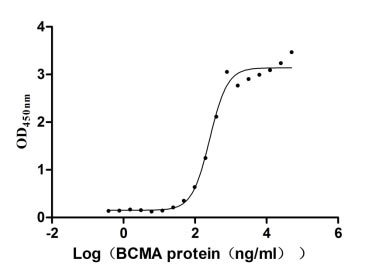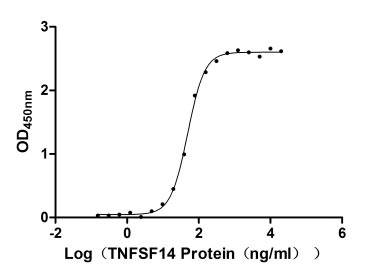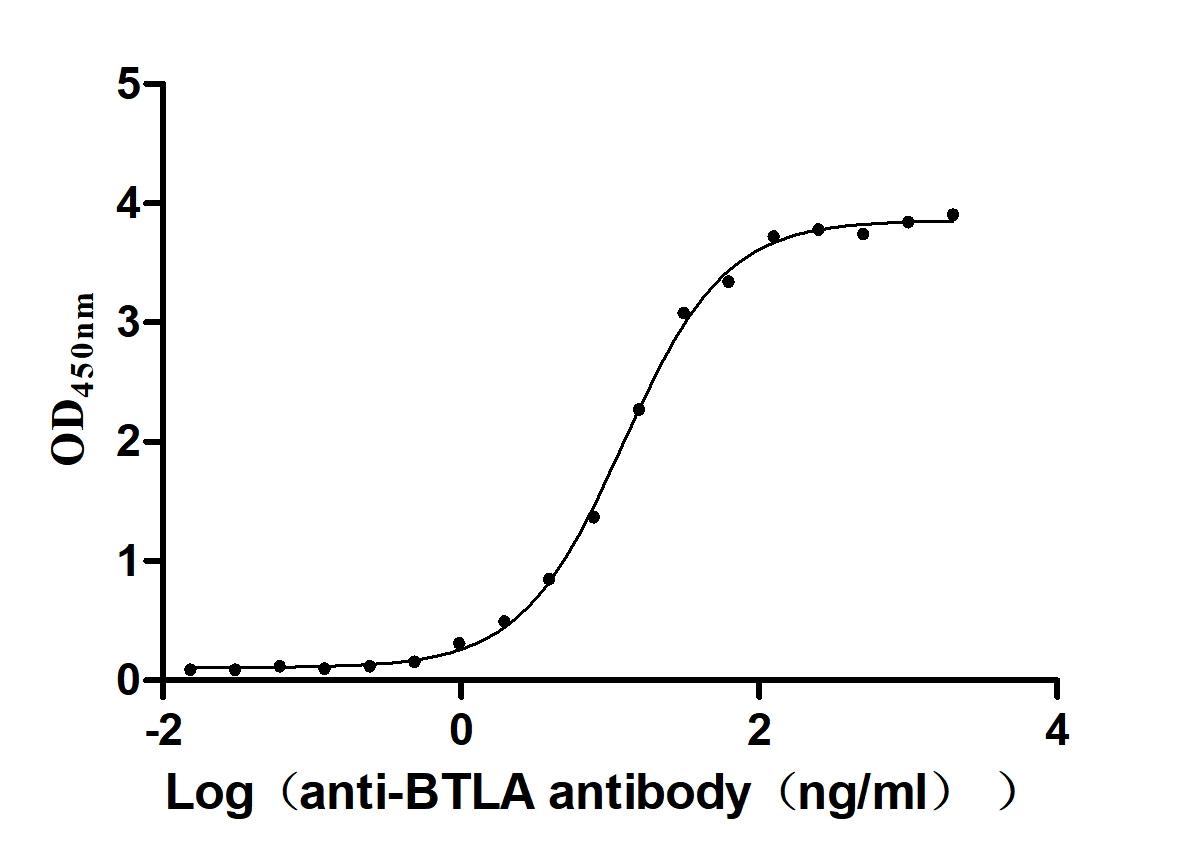Recombinant Mouse Docking protein 1 (Dok1)
-
中文名称:小鼠Dok1重组蛋白
-
货号:CSB-YP007107MO
-
规格:
-
来源:Yeast
-
其他:
-
中文名称:小鼠Dok1重组蛋白
-
货号:CSB-EP007107MO
-
规格:
-
来源:E.coli
-
其他:
-
中文名称:小鼠Dok1重组蛋白
-
货号:CSB-EP007107MO-B
-
规格:
-
来源:E.coli
-
共轭:Avi-tag Biotinylated
E. coli biotin ligase (BirA) is highly specific in covalently attaching biotin to the 15 amino acid AviTag peptide. This recombinant protein was biotinylated in vivo by AviTag-BirA technology, which method is BriA catalyzes amide linkage between the biotin and the specific lysine of the AviTag.
-
其他:
-
中文名称:小鼠Dok1重组蛋白
-
货号:CSB-BP007107MO
-
规格:
-
来源:Baculovirus
-
其他:
-
中文名称:小鼠Dok1重组蛋白
-
货号:CSB-MP007107MO
-
规格:
-
来源:Mammalian cell
-
其他:
产品详情
-
纯度:>85% (SDS-PAGE)
-
基因名:Dok1
-
Uniprot No.:
-
别名:Dok1; DokDocking protein 1; Downstream of tyrosine kinase 1; p62(dok)
-
种属:Mus musculus (Mouse)
-
蛋白长度:Full length protein
-
表达区域:1-482
-
氨基酸序列MDGAVMEGPL FLQSQRFGTK RWRKTWAVLY PASPHGVARL EFFDHKGSSS RGGRGGSRRL DCKMIRLAEC VSVVPVTVES PPEPGAVAFR LDTAQRSHLL AADAVSSTAW VQTLCRTAFP KGGWALAQTE NQPKFSALEM LENSLYSPTW EGSQFWVTSQ KTEASERCGL QGSYILRVEA EKLTLLTLGA QSQILEPLLF WPYTLLRRYG RDKVMFSFEA GRRCPSGPGT FTFQTSQGND IFQAVEAAIQ QQKAQGKVGQ AQDILRTDSH DGETEGKTVP PPVPQDPLGS PPALYAEPLD SLRIPPGPSQ DSVYSDPLGS TPAGAGEGVH SKKPLYWDLY GHVQQQLLKT KLTDSKEDPI YDEPEGLAPA PPRGLYDLPQ EPRDAWWCQA RLKEEGYELP YNPATDDYAV PPPRSPKPAP APKPQGLILP ESGTTRGSGS KGFSSDTALY SQVQKSGTSG AWDCGLSKVG NDRAGVKSEG ST
-
蛋白标签:Tag type will be determined during the manufacturing process.
The tag type will be determined during production process. If you have specified tag type, please tell us and we will develop the specified tag preferentially. -
产品提供形式:Lyophilized powder
Note: We will preferentially ship the format that we have in stock, however, if you have any special requirement for the format, please remark your requirement when placing the order, we will prepare according to your demand. -
复溶:We recommend that this vial be briefly centrifuged prior to opening to bring the contents to the bottom. Please reconstitute protein in deionized sterile water to a concentration of 0.1-1.0 mg/mL.We recommend to add 5-50% of glycerol (final concentration) and aliquot for long-term storage at -20℃/-80℃. Our default final concentration of glycerol is 50%. Customers could use it as reference.
-
储存条件:Store at -20°C/-80°C upon receipt, aliquoting is necessary for mutiple use. Avoid repeated freeze-thaw cycles.
-
保质期:The shelf life is related to many factors, storage state, buffer ingredients, storage temperature and the stability of the protein itself.
Generally, the shelf life of liquid form is 6 months at -20°C/-80°C. The shelf life of lyophilized form is 12 months at -20°C/-80°C. -
货期:Delivery time may differ from different purchasing way or location, please kindly consult your local distributors for specific delivery time.Note: All of our proteins are default shipped with normal blue ice packs, if you request to ship with dry ice, please communicate with us in advance and extra fees will be charged.
-
注意事项:Repeated freezing and thawing is not recommended. Store working aliquots at 4°C for up to one week.
-
Datasheet :Please contact us to get it.
靶点详情
-
功能:DOK proteins are enzymatically inert adaptor or scaffolding proteins. They provide a docking platform for the assembly of multimolecular signaling complexes. DOK1 appears to be a negative regulator of the insulin signaling pathway. Modulates integrin activation by competing with talin for the same binding site on ITGB3.
-
基因功能参考文献:
- findings demonstrate that Dok-3 and Dok-1/-2 play distinctive but cooperative roles in osteoclastogenesis and protect mice from osteopenia, providing physiological and pathophysiological insight into bone homeostasis. PMID: 29548825
- Platelets from Dok-1-/- mice displayed normal aggregation, activation of integrin alphaIIbbeta3, P-selectin surface expression, and soluble fibrinogen binding. These findings indicate that Dok-1 does not affect "inside-out" platelet signalling. PMID: 26790499
- These results reveal the critical involvement of Dok-1 and Dok-2 in a negative-feedback loop that prevents overactivation of CD8(+) T cells and promotes memory formation. PMID: 27664281
- Thus, Dok-1 and Dok-2 promote survival of glycoprotein B-specific CD8(+) T cells in trigeminal ganglia latently infected with herpes simplex virus 1. PMID: 28490594
- this study shows that Dok1 and Dok2 proteins are involved in the control of hematopoietic stem cell cycle regulation PMID: 27183638
- Taken together, our results demonstrate that Dok-1 and Dok-2 negatively regulate intestinal inflammation, apparently through the induction of IL-17A and IL-22 expression. PMID: 27450811
- Dok1 knockdown attenuated TLR2-induced NF-kappaB activation and IL-6 production in microglia. PMID: 23659921
- Triple Dok1 Doc2 Doc3 knockout leads to spontaneous pulmonary inflammation with hallmarks of asthma. PMID: 23205702
- Dok-1 overexpression promotes the generation of an innate-like CD8(+) T-cell population that expresses Eomesodermin. PMID: 22736313
- Studies using SHIP-1 shRNA, knockout mice and decoy inhibitors further indicate that CD4-mediated inhibition of TCR-mediated T cell activation is SHIP-1 and Dok-1/2 dependent, and involves SHIP-1 hydrolysis of Phosphatidylinositol 3,4,5-trisphosophate PMID: 22370159
- Dok-1 and Dok-2 deficiency induces osteopenia by activation of osteoclasts. PMID: 21732353
- these findings indicate that Dok-1, Dok-2, and Dok-3 cooperatively suppress aggressive HS PMID: 20548287
- Role of Dok1 in RET-mediated signaling PMID: 12087092
- crystal structure of the Dok1 phosphotyrosine binding domain alone and in complex with a phosphopeptide derived from RET receptor tyrosine kinase PMID: 14607833
- DOK1 and DOK2 interact with the Tec protein tyrosine kinase. PMID: 14647425
- X-ray crystallographic models of the PTB domain of mouse dok1 protein PMID: 14747716
- Our data suggest a novel pathway by which c-Abl transduces signals to the actin cytoskeleton through phosphorylating Dok1 Y361 and recruiting Nck. PMID: 15148308
- Dok1 tyrosine residues at 336 and 340 are essential for the negative regulation of Ras-Erk signaling, but dispensable for rasGAP-binding. PMID: 15189452
- Dok-1 is a key negative regulator of cytokine responses and is essential for myeloid homeostasis and suppression of leukemia. PMID: 15611294
- Dok-1 is critical in tumor suppression and control of the hematopoietic compartment homeostasis. PMID: 15611295
- Both SHIP and Dok1 functionally regulate the activation of Ras-Erk pathway by v-Abl and affect the mitogenic activity of v-Abl transformed bone marrow cells. PMID: 15655368
- Data suggest that Dok-1 and Dok-2 are essential negative regulators downstream of Toll-like receptor 4, implying a novel protein tyrosine kinase-dependent pathway in innate immunity. PMID: 15699069
- suggest Dok-1 and inositol polyphosphate-5-phosphatase D SH2 function in pathways that influence regulatory T cell development PMID: 16547230
- Nuclear export modulated by external stimuli and phosphorylation may be a mechanism by which Dok1 is maintained in the cytoplasm and membrane, thus regulating its signaling functions. PMID: 16705178
- Dok-1 and Dok-2 play an essential role in the negative regulation of T cell receptor signaling, and all mice lacking these proteins exhibited elevated titers of antibodies to double-stranded DNA and developed lupus-like renal disease. PMID: 17329234
- Dok-1 is a positive regulator of IL-4 signalling and IgE response. PMID: 17827176
- Upon phosphorylation of Tyr 747 in the beta3 integrin tail, however, Dok1 then binds much more strongly than talin. PMID: 18156175
- These results indicate that Dok1 promotes adipocyte hypertrophy by counteracting the inhibitory effect of ERK on PPAR-gamma and may thus confer predisposition to diet-induced obesity. PMID: 18204460
显示更多
收起更多
-
亚细胞定位:Cytoplasm. Nucleus.
-
蛋白家族:DOK family, Type A subfamily
-
组织特异性:Expressed in lung, spleen, skeletal muscle and kidney.
-
数据库链接:
KEGG: mmu:13448
STRING: 10090.ENSMUSP00000087079
UniGene: Mm.156
Most popular with customers
-
Recombinant Human Tumor necrosis factor ligand superfamily member 13B (TNFSF13B), partial (Active)
Express system: Mammalian cell
Species: Homo sapiens (Human)
-
Recombinant Human Tumor necrosis factor ligand superfamily member 14 (TNFSF14), partial (Active)
Express system: Mammalian cell
Species: Homo sapiens (Human)
-
Recombinant Human Signal transducer CD24 (CD24)-Nanoparticle (Active)
Express system: Mammalian cell
Species: Homo sapiens (Human)
-
Express system: Mammalian cell
Species: Homo sapiens (Human)
-
Recombinant Macaca fascicularis Trophoblast glycoprotein (TPBG), partial (Active)
Express system: Mammalian cell
Species: Macaca fascicularis (Crab-eating macaque) (Cynomolgus monkey)
-
Recombinant Human Myosin regulatory light chain 12B(MYL12B) (Active)
Express system: E.coli
Species: Homo sapiens (Human)
-
Recombinant Human B- and T-lymphocyte attenuator(BTLA), partial (Active)
Express system: Mammalian cell
Species: Homo sapiens (Human)
-
Recombinant Human C-C chemokine receptor type 9 (CCR9)-VLPs (Active)
Express system: Mammalian cell
Species: Homo sapiens (Human)




















